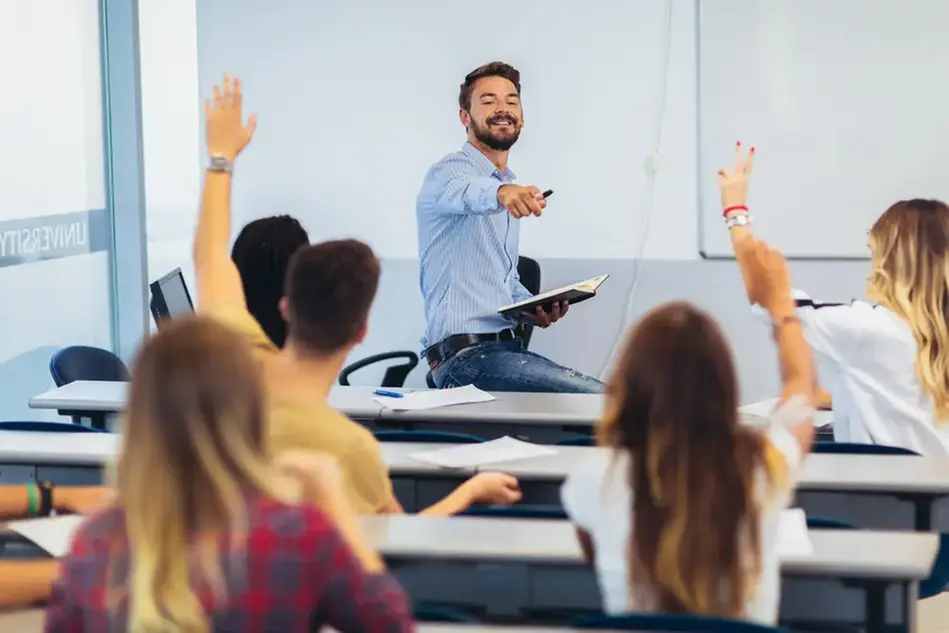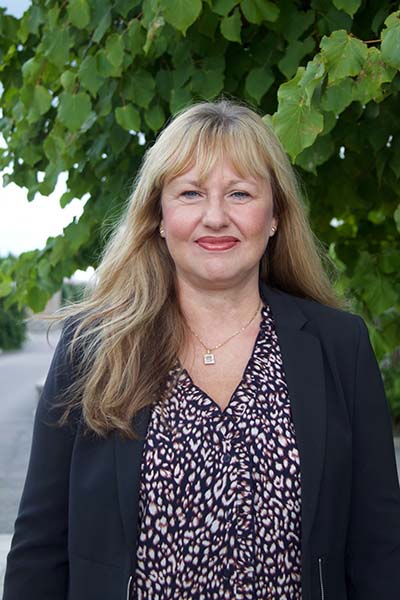Professor’s portrait: Sylvana Sofkova Hashemi wants to support teachers in their work
Language in many nuances is important to Sylvana Sofkova Hashemi, new Professor of Digital Learning at Halmstad University. She is interested in the diversity of ways in which not least children and young people express themselves, where text and speech mix in multimodal constellations with photos, symbols, and music. Teachers’ perspectives and questions also capture her attention, and one area is didactic design – when subject, space, and technology interact in school.
“There is a need in the school to develop text competence to understand and communicate multimodally.”
Sylvana Sofkova Hashemi, Professor of Digital Learning
Sylvana Sofkova Hashemi has extensive experience of conducting internship development research with a focus on digitalisation and she was happy to see that Halmstad University was looking for a Professor of Digital Learning.
“I thought, that is exactly what I am doing,” she says.
The combination of language, technology, and learning has always been important for Sylvana Sofkova Hashemi’s research focus. She speaks seven languages. It can thus be determined she has an interest in and an ear for language. She is a trained computer linguist – now called language technologist – a new education at the time that aroused 19-year-old Silvana’s curiosity: the technology focus in combination with the programme being offered in Gothenburg. The choice provided a natural way to move out of her home in Uppsala.
Written language and social media
Sylvana Sofkova Hashemi’s research career began with a focus on literacy and especially written language. She wrote her doctoral thesis on how children’s writing is supported by digital grammar checker tools.
“The writing tools were not adapted for students in grades 4–6 and, instead of understanding what the tools could offer, the programs were closed to the students. I see that tendency all the time. Look at the debate about the mobile phone; instead of dealing with the issue at school and discussing what technology offers and means to us humans, its use is forbidden.”

“Occasionally, there are alarming reports that children and young people read far too little these days, and they probably do. But the question is whether reading is something else for the rising generation? We need to rethink: what do our children think reading is? Maybe that is the next research project?” ponders Sylvana Sofkova Hashemi.
After the defence of her doctoral thesis, she studied language and social media strategies in a project funded by the Swedish Research Council. It was about adults worrying that their children were destroying their language by writing online and texting, for which the cost at the turn of the millennium related to the length of the message. As it turned out, the creativity of children and young people partly came from that limitation. They adapted the text to the space, the cost, and who the text message was for. For several years, Sylvana Sofkova Hashemi monitored students’ written language in various arenas inside and outside the school.
“Back then, Lunarstorm was the place to be for young people. It was like a hideaway for friends, and we saw that students in their teens were incredibly creative and used abbreviations, capital letters, and sometimes almost poetic expressions. At the same time, we saw in interviews with the approximately 80 students that they were careful to write correct Swedish in many contexts.”
She has also studied how mobile phone apps can be used when integrating newly arrived adults and saw that the apps were not adapted to the needs of newly arrived migrants.
“As for the teachers that the newly arrived migrants encountered, we saw they need to find out what technology can offer and develop the teaching in that way.”

”I want to support the teacher’s work, where I believe I can contribute,” says Sylvana Sofkova Hashemi.
Teachers’ questions and perspectives
Sylvana Sofkova Hashemi’s research has increasingly developed into teachers’ questions and perspectives, questions about didactics and internship development research, mainly linked to digitalisation. She sees that it is not at all uncommon for a teacher to receive a digital tool – the hardware itself – and then digitalisation is considered to be on track. ‘Check’, so to speak.”
“I want to support the teacher’s work; that is where I believe I can contribute. Digitalisation is a complex issue. With digital tools and apps, you need to figure out how to use them and which students benefit from them. You do not have to do the same for all students.”
In an EU-funded project in collaboration between Sweden, Denmark, and Norway, Sylvana Sofkova Hashemi has worked to develop models for how to implement technologies in teaching. The book ’Digital kompetens för lärare’ (Digital competence for teachers), of which she is the editor, discusses what teachers and school management need to know in order to be able to contribute to a research-based development of the digital competence of students and teachers. The book ’Kollaborativ undervisning i digital skolmiljö’ (Collaborative teaching in a digital school environment), edited by Sylvana Sofkova Hashemi, discusses questions such as how teachers can use digital tools in the design of their teaching and how they should be used to provide the best added value. The framework described in the book, the so-called thought cubes, highlights the didactic aspects of teaching by combining content and goals in the subject with educational strategies and the use of technology.
Research on school design
In the current research project DigiFLEX: ’Digital praktik i flexibla klassrum – didaktisk design’ (Digital practice in flexible classrooms – didactic design) in collaboration within ULF (which stands for development, learning, research – the Government’s investment in practical research) led by Sylvana Sofkova Hashemi, the researchers examine how school design affects teaching and learning. She monitors newly built schools that have invested in modern design with flexible classrooms and nooks and crannies. These have been equipped with digital technology, the possibility of great mobility, and with furniture in different sizes and shapes.

Newly built schools that are studied are equipped with the possibility of great mobility and with furniture of different sizes and shapes. (The image is not from any of the schools included in the research project.)
“The schools are designed based on an ideal similar to the OECD’s key competencies for the 21st century, highlighting creativity, digitalisation, and critical thinking. Together with teachers, we develop didactic models. In the changed learning environment, there are new possibilities for teaching. At the same time, this becomes a challenge for teachers who are used to traditional classrooms.”
And this brings us back to the importance of language. The text worlds in which today’s children and young people navigate and develop their language also offer – as technology develops – many and different ways of expressing themselves. The texts have become much more multimodal – in addition to speech and written text, they include, for example, symbols, photos, film, animations, music, and design thereof.
Text competence – a democracy issue
“There is a need in the school to develop text competence to understand and communicate multimodally. Understanding information and safely navigating an increasingly complex society is a democracy issue, and it is important to be able to interpret, critically examine, and participate in communication.”

Sylvana Sofkova Hashemi
With digital tools in the classroom, the school needs to pay attention to what the students are communicating and meet this with a pedagogy that covers the entire language use and communication.
“From the teachers’ perspective, we must develop a practice, both in the teaching itself and also a professional language for how we make assessments. The students have access to different forms of expression and it is important to also give ‘credit’ for this. The educator must not end up only assessing what the student has written or recounted without looking at what is said in the picture or film that they have created. The teacher also needs to see the complete picture and use different forms of expression in storytelling.”
Details and patterns
Sylvana Sofkova Hashemi is driven by curiosity and the potential she sees in people she meets.
“I like to dig into details and recognise patterns, to meet teachers and students and see what happens.”
Sylvana Sofkova Hashemi thinks becoming a professor is wonderful and bewildering. It is a confirmation of what she has been doing for many years, and also a title that comes with obligations and responsibility. It is especially exciting to be on site at a new university where digitalisation in society is key.
“Working with questions about digitalisation in school and teacher education is close to my heart. I believe I have the best job and that is both an advantage and a disadvantage. In my time off, family is my focus, and I walk in the woods and am a little creative – I enjoy painting.“
But what about the seven languages – how did you learn that many?
“I come from the Czech Republic, and it was mandatory to study Russian, so I got Czech and Russian as a package deal. I also started studying German in the Czech Republic. Then I came to Sweden and discovered that it was quite easy for me to learn languages. I was a teenager at the time. My parents went to ’Studiefrämjandet’ and studied Swedish, but I learned faster and had to handle much of the communication in the family,” says Sylvana Sofkova Hashemi and continues:
“I studied Spanish in upper secondary school. At work, English was partly the standard, so it became a professional language for me. When I met my future husband, who is from Iran, I learned Farsi.”
Text: Kristina Rörstöm
Picture: iStock, Sara Hasemi
About Sylvana Sofkova Hashemi
Sylvana Sofkova Hashemi studied a Master of Philosophy in Computer Linguistics at Gothenburg University, 1994, and in 2003 defended her doctoral thesis in General Linguistics specialising in Computer Linguistics at Gothenburg University with the dissertation Detection of Grammar Errors in Primary School Children’s Texts. A Finite State Approach.
Associate Professor in Educational Science 2014, specialisation Learning and IT, at University West. The Associate Professor’s lecture was called Written language and creation of meaning in technology-mediated worlds – significance to the school’s text culture. Employed at the Department of Pedagogical, Curricular and Professional Studies, University of Gothenburg 2015–2021. Since 2017, Deputy Head of Education at third cycle level, Department of Pedagogical, Curricular and Professional Studies, University of Gothenburg.
She is the chair of the national network TIMDA: Texts, Information and Multimodality in the Digital Age Network and runs an international research environment on Didactical Design in Classroom Research. Professor of Digital Learning at Halmstad University 2021.

